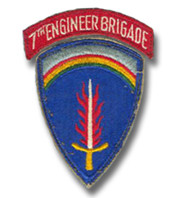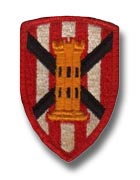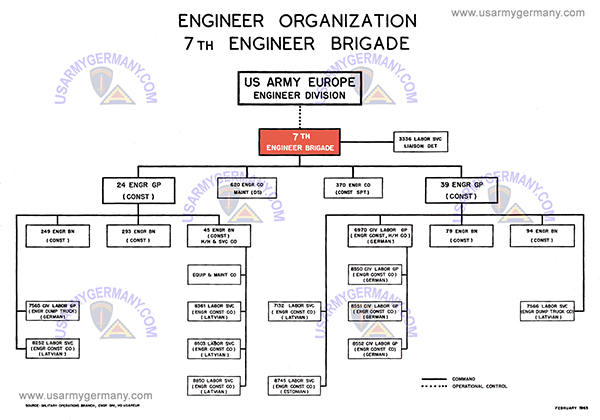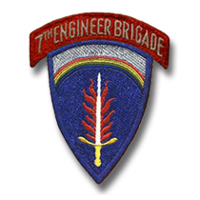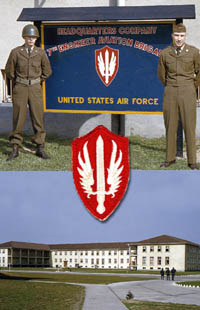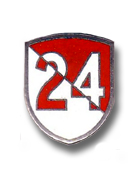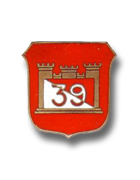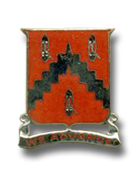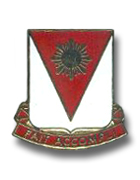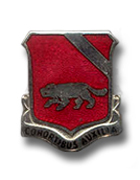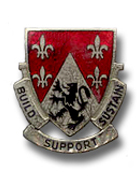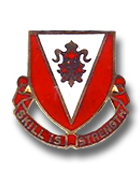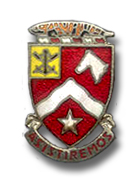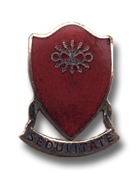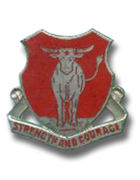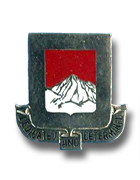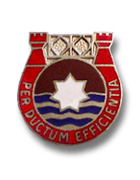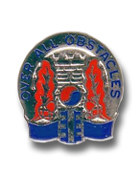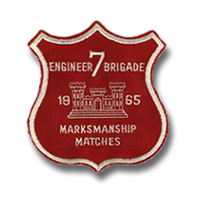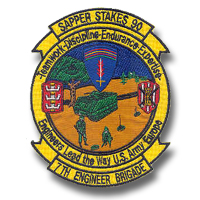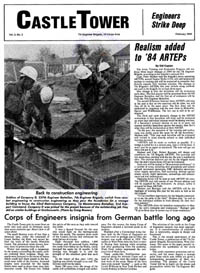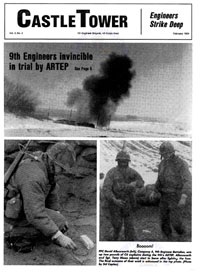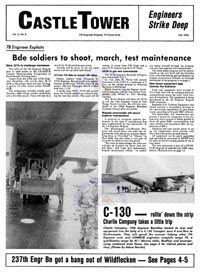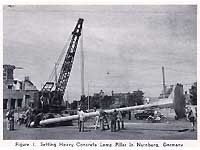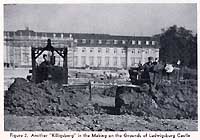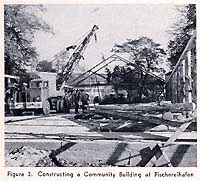| If you do
NOT see the Table of Contents frame to the left of this page, then
Click here to open 'USArmyGermany' frameset |
||||||||||||||||||||||||||||||||||||||||||
7th Engineer Brigade |
||||||||||||||||||||||||||||||||||||||||||
|
|
||||||||||||||||||||||||||||||||||||||||||
|
||||||||||||||||||||||||||||||||||||||||||
|
|
||||||||||||||||||||||||||||||||||||||||||
| 7th Engineer Brigade History | ||||||||||||||||||||||||||||||||||||||||||
| 1956 - 1991 | ||||||||||||||||||||||||||||||||||||||||||
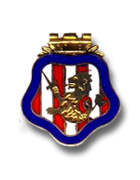 7th Engineer Brigade DI
7th Engineer Brigade DISources: "Engr Bridge Tough Spots," JAYHAWK Anniversary Issue, August 19, 1970 7th Engineer Brigade History, Public Affairs Office, HQ 7th Engr Bde (late 1980s) "The 7th Engineer Brigade," by Maj Al Bornmann and SGM Larry David. ENGINEER, Summer 1980 "Leading the Way," JAYHAWK, August 1982 |
||||||||||||||||||||||||||||||||||||||||||
|
||||||||||||||||||||||||||||||||||||||||||
| MAJOR SUBORDINATE UNITS - 1950s | ||||||||||||||||||||||||||||||||||||||||||
|
||||||||||||||||||||||||||||||||||||||||||
|
The 7th Engineer Brigade became a member of the VII Corps on June 14, 1969, relocating to Ludendorff Kaserne, Kornwestheim. Upon joining VII Corps, the Brigade activated six battalions under its headquarters. Personnel (and equipment) for the brigade were transferred from the 540th and 555th Engineer Groups, which were subsequently inactivated. |
||||||||||||||||||||||||||||||||||||||||||
|
||||||||||||||||||||||||||||||||||||||||||
|
Also,
the brigade routinely participated in Partnership Projects with
their German partnership units. Exercises from squad to brigade
level with the VII Corps' maneuver commands were common-place throughout
Germany and other NATO training areas. Corps level command post
and field exercises complemented the full training program.
A big step in the brigade was the mechanization of the engineer battalions. Two battalions were mechanized in 1985-86, and another in 1987. The addition of armored personnel carriers to the sappers redefined and accented the combat role that the brigade played in the Army's airland battle doctrine. Annual battalion level exercises that units participated in included BRIDGEX and CEMTAP. BRIDGEX was a battalion size combat bridging exercise at dry span and wet sites. The exercise provided the opportunity for the engineers to practice bridging to ARTEP standards, in addition to the river crossing operations so important ot their combat support role. Both individual soldier skills and small unit cohesion were honed to wartime demands. CEMTAP was a construction exercise in which each battalion participated. During CEMTAP major training areas were upgraded. During CEMTAP rotation, the battalions also incorporated common task testing, weapons qualification, along with concurrent training activity. |
||||||||||||||||||||||||||||||||||||||||||
|
In
the late 1980s, the 7th Engineer Brigade comprised the following
units:
|
||||||||||||||||||||||||||||||||||||||||||
|
||||||||||||||||||||||||||||||||||||||||||
| On June 22 1991, the 7th Engineer Brigade was inactivated in Germany. | ||||||||||||||||||||||||||||||||||||||||||
| (Source: STARS & STRIPES, June 28, 1969) | ||||||||||||||||||||||||||||||||||||||||||
| 7th Engineer Brigade was formed in June 1969 through the consolidation of two former engineer groups: the 540th Engr Gp and the 555th Egr Gp. During a ceremony held at Kelley Barracks on June 26, Col Howard B. Coffman, Jr. assumed command of the new unit. As part of the reorganization, two engineer battalions (563rd and 565th) were activated to provide centralized command and control for several separate engineer companies which had previosuly been under group control. |
||||||||||||||||||||||||||||||||||||||||||
| MAJOR SUBORDINATE UNITS - 1970s | ||||||||||||||||||||||||||||||||||||||||||
|
||||||||||||||||||||||||||||||||||||||||||
|
|
||||||||||||||||||||||||||||||||||||||||||
| 7TH ENGR BDE MISC. PATCHES - 1950s - 70s | ||||||||||||||||||||||||||||||||||||||||||
|
||||||||||||||||||||||||||||||||||||||||||
| CASTLE TOWER - Some of the issues published while in Germany | ||||||||||||||||||||||||||||||||||||||||||
|
||||||||||||||||||||||||||||||||||||||||||
* Note: Editor forgot to change Date and Issue No. on the masthead - should be March 1984, Vol. 3 No. 3 |
||||||||||||||||||||||||||||||||||||||||||
|
|
||||||||||||||||||||||||||||||||||||||||||
|
CORRECTION
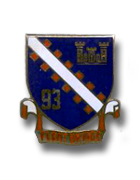 93rd Engineer Company DI
93rd Engineer Company DI(Source: Email from Mike Sanders) |
||||||||||||||||||||||||||||||||||||||||||
|
I
noticed on your website that you show the 565th
Engineer Bn as being HQ'd in Ettlingen. I was with the
93rd Engineer Co from 1986-1989, and the Bn HQ was located about
100 yards from my barracks on Neureut Kaserne in Karlsruhe.
|
||||||||||||||||||||||||||||||||||||||||||
| If you have more
information on the history or organization of the 7th Engr Bde, please
contact me |
||||||||||||||||||||||||||||||||||||||||||
|
|
||||||||||||||||||||||||||||||||||||||||||
| 1953 | ||||||||||||||||||||||||||||||||||||||||||
| (Source: THE MILITARY ENGINEER, May-Jun 1954, Society of Military Engineers, Wash. D.C.) | ||||||||||||||||||||||||||||||||||||||||||
| Community
Aid in Germany Trained Army Engineer troops, using their heavy equipment, are leaving their mark in Germany. Dozens of construction jobs have been completed which benefit the cities and the rural areas. The work, ranging from all types of construction to clearing and earthwork, not only aids the people of the war-battered country but also adds practical experience to troop training schedules. Much of the labor is done by soldiers on their off-duty time. Their weekend work saves months of toil that would be required if the jobs were to be done by Germans using hand tools. No official estimate of the value of this work has been made but it is believed to exceed $500,000 a year. Typical of this aid was the reclaiming of more than 80 acres of wasteland, near the central German city of Giessen, which was badly needed for farming. Three men from the 354th Engineer Construction Battalion used heavy bulldozers to fill bomb craters and cover old gun positions in the area. They leveled rock and distributed rich topsoil, accomplishing in one weekend a job that would have taken hand-workers several months. The 807th Engineer Light Equipment Company undertook the job of removing rubble from the Bundesbahn (German federal railway) which required the work of a mechanized five-man crew for a week. The team filled sixty freight ears with more than than 600 cubic yards of rubble. Countless sports fields have been leveled and completed by engineer units throughout the American Zone and basements and foundations for schools and public buildings have been dug. Aid is extended in summer by the construction of swimming pools and in winter by removal of snowbanks too deep to be handled by the local equipment of the towns. A unique project is the clearing of the Ludwigsburg Castle grounds to prepare a replica of the famous Stuttgart "Killigsberg" or outdoor garden, where national flower shows were held in previous years. The 503d Engineer Light Equipment Company is furnishing men and machinery to make the rock garden ready for the spring opening. The laying of a city park in Weissenhorn, a town in the Danube valley, was a project of the 54th Engineer Construction Battalion. The distance from the park to the camp was too great to move heavy road graders and dump trucks bark and forth each daL°, so tile people of tile town furnished rooms and meals for the soldiers while tile work was in progress. Many refugees from behind the Iron Curtain who have fled from the East are building homes in community projects. Sand and rock to make concrete are always difficult to obtain. To help in this matter, engineer units strip-mine sand for the homes and blast quarry rock in realistic training activities. After quarry blasts for foundation rock, the Army keeps gravel for road repair. The bridges and roads constructed by the engineers during maneuver periods are definite coutributions to the German public works program, and bridges and overpasses built for the civilian users serve military purposes as well. Recently, the police in a small Bavarian village asked the engineers to assist in uprooting a forest of tree stumps which were to be given to needy families for firewood. The troops gladly complied, arid receivcd some excellent demolition practice in the process. But the 547th Combat Engineers received the most unusual request of all recently in Gross-Urnstadt, near Darmstadt. No bulldozers, road graders or steam shovels were involved this time. The sponsors of a youth festival wanted to know if the battalion could provide a dance band. The 547th organized a "combo" for the occasion. The Army likes to answer all the German requests it can, keeping training schedules and budgets constantly in mind. And most of. the time the service results in advantage to all concerned: experience for the engineers and grants-in-aid for the German people. |
||||||||||||||||||||||||||||||||||||||||||
|
|
||||||||||||||||||||||||||||||||||||||||||
|
|
||||||||||||||||||||||||||||||||||||||||||
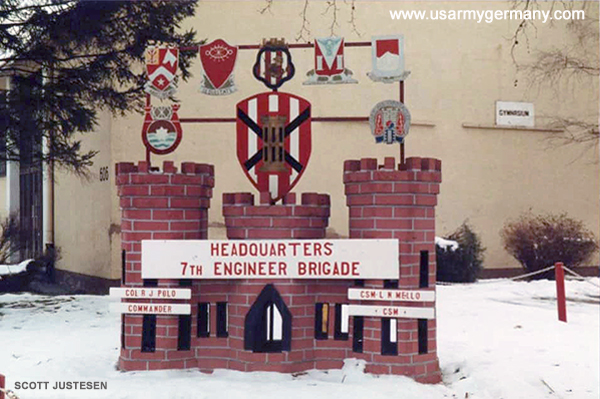 7th Engineer Brigade, Ludendorff Kaserne, Kornwestheim, 1982 (Scott Justesen) |
||||||||||||||||||||||||||||||||||||||||||
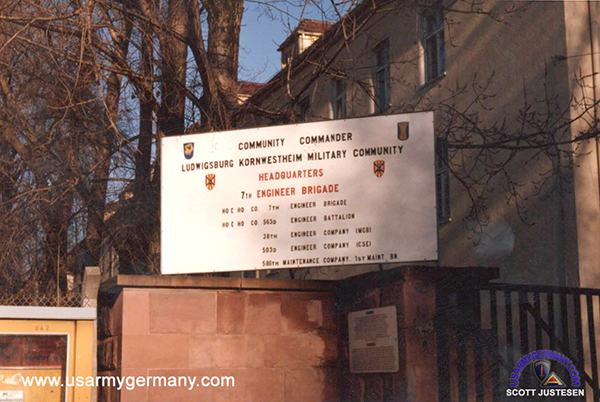 Sign at main gate, Ludendorff Kaserne, Kornwestheim, 1982 (Scott Justesen) |
||||||||||||||||||||||||||||||||||||||||||
| 1980 | ||||||||||||||||||||||||||||||||||||||||||
| COL Richard J. Polo, Commander, 7th Engineer Brigade | ||||||||||||||||||||||||||||||||||||||||||
| I commanded the 7th Engineer Brigade, was the VII Corps Engineer, and the Commander of the Ludwigsburg Community, from June 1980 to June 1983, the longest period of any Brigade Commander. (The Command tour had been extended to 3 years and was later cut back.) The Brigade had the motto of "Engineers - Lead the Way" and had a very high morale. Besides the training exercises described in the history of the Brigade, we participated in a Reforger exercise in which we were augmented by a Reserve Engineer Command from the United States. For this exercise, using metal pallets, we built an airstrip in which the planes from the States landed. We also built refueling points for the planes and helicopters carried by them. The reinforcing units were processed, they were equipped with materiel taken out of POMCUS sites, and went on to participate in a major USAREUR wide FTX. While I was with VII Corps, the 7th Engineer Brigade built many German Community projects, and also several projects to improve the many Kasernes occupied by VII Corps units. The Brigade units participated in many activities with German Army units with which they established partnership relationships. We participated in many visits to German Army installations, and they took our officers to visit old Roman forts. It was an enjoyable and satisfying tour. Not mentioned in the history of the Brigade, is that later it deployed to Saudi Arabia and participated in the Gulf War and invasion of Iraq. In two earlier tours in Germany I served in the 9th Engineer Battalion. The first time as a Lieutenant and Captain from 1962 to 1965, in both Company A and Headquarters Company. Once a year the Battalion would go to Wildflecken for training, and all the wives went to Wildflecken to visit on Sundays. We would go to a Monastery across the road from Wildflecken to eat and drink Beer, and to tour the fields of the Monastery. We all had a good time. Then late in 1960, A Company was designated to support another Battalion and deploy to Bad Hersfeld for a month to assume their ADM missions on the German border in that area. All the wives went. We had a good time even though we had a lot to do with the Platoons taking turns inspecting the targets, updating the target folders, and training. We had a nice apartment there. We went to see a Circus that came around to town. We suspect that it was in Bad Hersfeld that Jim was conceived. In the Battalion we had to make frequent river crossing exercises, because if we went to war, we would have to bridge the Rhine to evacuate family members who would have to go to both the Ramstein Air Base by Kaiserslautern, and to the Frankfurt airport (for which the bridge was not needed). The crossing of the Rhine was a big deal. It required building the bridge from ends, assembling and ferrying the completed rafts to the segments of bridge that would be joined from both ends. Since we had only a limited time period for the actual closing of the river to river traffic, the bridge segments were held from washing downstream with bridge boats allowing the river barges to pass through the opening. Then at the time that we were granted permission to close the river, the barges would be held from continuing, the anchor cable and bridle lines were put in, the bridge would be closed, and traffic would be symbolically crossed over the bridge to the other side of he river. We also had the Companies train in building bridges across the Main River, the Danube River by Ingolstadt and other places. The procedures were the same, but less elaborate since the bridges were shorter. It was customary to celebrate the closing of one of these bridges by throwing the Officer into the River from the centerline of the bridge where the last raft had been joined. On one occasion the weather was already cold. I was thrown by my men, and came out wet and cold. I changed and climbed into my bed sack in the tent, but in spite of the pot belly stoves, I could not get warm. I had shivers in the morning and a high fever. The Battalion doctor made me go in for X-rays, and I entered the debriefing room in Smith Kaserne at the very moment that he was announcing that I had contracted primary atypical pneumonia. The Battalion Executive Officer joked about modern medicine getting me well fast, and I was not amused at all. I was put into the dispensary where I had to stay for about a week receiving penicillin shots until I could be released to go home. We had practice alerts from time to time. My field gear was packed, and my driver and jeep would come to pick me up in case of one of these alerts. He would stow my gear in the trailer, and we would go off to report to the Kaserne, to then go to the field to disperse and camp out until the alert was called off and we were released. That usually happened after we had served at least one meal in the alert assembly area. This was rather routine in that time when we were facing off the Soviet Union across the West Germany international boundary. At this time, we were immune from German laws, and for that reason were treated like royalty everywhere. I remember that in one convoy on an iced road, we were stopped on the side of the narrow road when a small German civilian automobile tried to pass the convoy. A Captain who was the Headquarters Company Commander stopped him, put his foot on the fender of the font wheel, and pushed him into the ditch on the other side of the road. I was given a number of projects to execute with my Platoon. One of these was the construction of a firing site for Hawk surface to air missiles on the outskirts of Hanau. We built a number of high earthen berms to separate the different firing positions and provide them a degree of protection from retaliatory fire. It was challenging to use the heavy equipment to build up the berms while retaining the slopes. I had another platoon attached to me, and the Lieutenant in charge of that Platoon created a morale problem by flying kites from the berms under construction. I had the Company Commander replace that Platoon on the project. Another project assigned to me was to construct an exclusion area for the storage of nuclear weapons inside a military base in Darmstadt. This project was for the Directorate of Engineering of Darmstadt. It included building igloos with earth cover, a double fence around all the igloos which had challenging features, a failsafe electrical generator system, a lighting system that would turn the generator and the lights on if the normal electrical supply was interrupted or if the power feeding cables were cut. An interesting part of the design was that all the electrical cables had to be buried, and all connections had to be protected from water infiltration and rodents. Thus we had to encase them in rubber that we casted around them by filling a plastic casing with liquid rubber that had a hardening agent that we had to add. It was a very sophisticated project. When it was given the final acceptance inspection, we were commended for our flawless work. The commendation letter said that the completed project passed the inspection without a single deficiency. *** I was told to be ready for war, but not to alarm my family nor tell them what was happening. That they would be taken care of, and if necessary they would be evacuated following the NEO Plan for evacuation of family members in case of war. (I think NEO stands for Noncombatant Evacuation Operations.) The Plan required them to be prepared for evacuation and told them what they could take of their personal possessions, and what things they had to have packed and prepared to take with them, such as clothing and coats, medicines and limited amounts of food. The convoy on the autobahn was successful and eventually our life returned to normality. 9th Engineer Battalion, 1971-73 I assumed Command of the 9th Engineer Battalion in a ceremony in the Gym at Smith Kaserne. I do not remember the name of the previous Battalion Commander from whom I assumed command. Major David Byrnes became my Executive Officer, and another Major was my S3. |
||||||||||||||||||||||||||||||||||||||||||
| 1980 | ||||||||||||||||||||||||||||||||||||||||||
| COL Samuel C. Railes, Commander, 7th Engineer Brigade | ||||||||||||||||||||||||||||||||||||||||||
| I was the last
commander of 7th Engineer Brigade (1989-91). I served in the Brigade in 1974/75 as Commander, Company B, 82d Combat Engineer Battalion, Bamberg, Ge.; as Commander, 563d Engineer Battalion in 1983-85, Ludendorff Kaserne, Kornwestheim, Ge, and took over the Brigade in June 1989. In addition to commanding the Brigade, I served as the VII Corps Senior Engineer and as Commander of the Ludwigsburg/Kornwestheim Military Sub-community. The Brigade deployed with VII Corps for the Gulf War. We grew to over 8,500 soldiers, three Groups, 10 Battalions, and assorted companies. The Brigade HQ received a Meritorious Unit Combat Citation for Desert Storm. Samuel C. Raines COL (Ret) |
||||||||||||||||||||||||||||||||||||||||||
|
|
||||||||||||||||||||||||||||||||||||||||||
| Patch Variant | ||||||||||||||||||||||||||||||||||||||||||
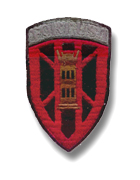 Variant of the
standard 7th Engineer Brigade shoulder patch
Variant of the
standard 7th Engineer Brigade shoulder patch |
||||||||||||||||||||||||||||||||||||||||||
| A
collector of US military patches has recently acquired a rather unusual
variation of the 7th Eng. Brig. patch. It appears to have been made
in Germany and is of wool construction having a red background with
black lines and a green castle. At the top of the patch is an attached
gray tab with "Fort USA". It has been removed from a uniform. If anyone has information on this specific variation of the 7th Engineer patch, please send email to me. Of special interest is the significance of the "Fort USA" tab. |
||||||||||||||||||||||||||||||||||||||||||
|
|
||||||||||||||||||||||||||||||||||||||||||
| 275th Engineer Company (ADM) | ||||||||||||||||||||||||||||||||||||||||||
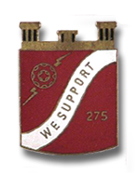 275th Engineer Company Insignia (1960s; pre-ADM mission?) 275th Engineer Company Insignia (1960s; pre-ADM mission?) |
||||||||||||||||||||||||||||||||||||||||||
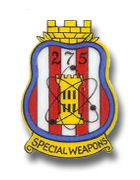 275th Engineer Company Insignia (1970s) 275th Engineer Company Insignia (1970s) |
||||||||||||||||||||||||||||||||||||||||||
| For more information on the ADM units in USAREUR, click here | ||||||||||||||||||||||||||||||||||||||||||
| 1975 | ||||||||||||||||||||||||||||||||||||||||||
| (Source: Email from John Williams) | ||||||||||||||||||||||||||||||||||||||||||
| I just read the history on the site about the 275th Engineer Co ADM. It was very informative and interesting. To Add to this if so desired. I was in the 10th Engineers (Bn) 3rd Infantry prior to the 275th. In 1975 all ADM platoons were reassigned to the newly organized 275th Engineer Co ADM. The ADM platoons throughout Germany were grouped here. At that time, as in all military units, our mission was to support all Europe missions in NATO. Our primary missions still stayed with our prior units. The 5th Platoon in which I was a Team Leader was to support the 3rd Inf. Div. I left there in Sept 1977 and up to that time my team never failed a fire mission inspection. In 1975 we raised the US flag over our newly formed company. It had flown over the White House and sent to us to raise. |
||||||||||||||||||||||||||||||||||||||||||
| 1980 | ||||||||||||||||||||||||||||||||||||||||||
| (Source: Email from Dave Hodgeboom, Engr ADM Pltn, 36th USAFAD) | ||||||||||||||||||||||||||||||||||||||||||
| The ADM Platoon came to the 36th USAFAD from the 275th Engineer Co (ADM) in Ludwigsburg (VII US Corps) when the NATO Support Platoons where assigned to the 59th Ordnance Brigade in 1980. I was assigned to the detachment in 1981 as the Engineer ADM Platoon Sergeant. The platoon consisted of 3 Engineer ADM emplacement teams and platoon headquarters each required to assemble and fire the two ADM weapons systems. The platoon supported the 210th Pionier (Engineer) Kompanie, II GE Corps (Munich). While I was there, the platoon successfully passed 3 separate Nuclear Weapons Technical Inspections with no comments or deficiencies. As part of the detachment, we supported the artillery platoon on their inspections and performed site guard as part of the normal rotation. From 1975 until 1980, the 7th and 9th Engineer ADM Platoon of the 275th Engineer Co (ADM) in Ludwigsburg (VII US Corps) supported the 310th Pionier Kompanie (Koblenz), III GE Corps. The 59th Brigade unit that the platoon supported was the 557th Artillery Group for Herborn-Seelbach. The platoon consisted of 9 Engineer ADM emplacement teams each required to assemble and fire the two ADM weapons systems and 2 platoon headquarters. This platoon deployed over 200 miles across two corps sectors to meet its mission. The 6th Platoon and 8th Platoon of the 275th Engineer Co (ADM) supported the 210th Pionier Companie in Munich. These later became the platoons at the 24th USAFAD (6 teams) and 36th USAFAD (3 teams) respectively. The US unit they supported was the 512th Artillery Group in Neu-Ulm. |
||||||||||||||||||||||||||||||||||||||||||
| 503rd Engineer Company | ||||||||||||||||||||||||||||||||||||||||||
| 1949 | ||||||||||||||||||||||||||||||||||||||||||
| (Source: Donald Hess, 503rd Engr Co, 1949-53) | ||||||||||||||||||||||||||||||||||||||||||
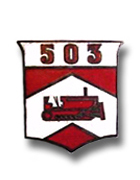 503rd Engineer Company DI 503rd Engineer Company DI |
||||||||||||||||||||||||||||||||||||||||||
I was one of the original members the 503rd Engineer Light Equipment Company in
Anyone having knowledge of the 503rd during this period of time please contact or email Don at |
||||||||||||||||||||||||||||||||||||||||||
| The Early Years Following is a short outline of the company’s history that I have compiled so far. In January 1949 we were stationed at Pioneer Barracks, At its inception this company was called “Company E of the 7742 Engineer Base Depot Group” (stationed at In late June 1949 Company E’s status was changed from a temporary to a permanent unit and was renamed as the 503rd Engineer Light Equipment Company. In Sept 1949, with the job in During our stay at Taylor Barracks, the 503rd was Regular Army and wore the EUCOM shoulder patch. Later we were attached to the 555th Combat Group, then the 77th Engineer Construction Battalion. Both were part of 7th Army. We switched to the 7th Army patch sometime in 1950. At Taylor Barracks we were involved in German-American Friendship projects such as building sports fields etc, with individual machines and up to Platoon levels but nothing requiring the full company. As the Cold War became hotter, we were increasingly being sent into the French Zone of occupation near In 1950 the French Zone roads and economy were lagging far behind the British and American Zones. The 1950’s increased escalation of the Cold War mandated the French zone roads be upgraded. Both ends of an Autobahn bridge near Kaiserslauter were destroyed by German engineers near the wars end resulting in long stretches of the autobahn being useless. The 503rd built a by pass road around the bridge to facilitate traffic movement on the Autobahn if needed. We also spent several weeks in late 1950 at Etain, France off-loading equipment and other supplies being shipped in to stock the depots under construction. In early 1951, the entire company moved from Taylor Barracks, Mannheim to Ettlingen, near In May 1952 the 503rd moved from As I understand it, the 503rd remained at Ludendorff under the 540th Engineer Group for many years. It was deactivated 1992 at Hohenfels Germany. |
||||||||||||||||||||||||||||||||||||||||||
| 1954 | ||||||||||||||||||||||||||||||||||||||||||
| (Source: Email from George Perry, 503rd Engr Co, 1954) | ||||||||||||||||||||||||||||||||||||||||||
| The 503d Engineer Company was reconstituted in 1948 to assist in the construction of an additional airstrip at Tegel aerdrome. Its equipment was provided by cutting up heavy equipments and flying it into Berlin for rebuilding for use. I am interested in any information on the availability of photos or (especially) movie -- newsreel footage -- that might show members of the 503d at work. I moved to an island in S. Puget Sound 7 years ago, and discovered a fellow living on the same island who served as an air traffic controller at Tegel during the construction mentioned above. He recalls doing traffic control work while situated in a tower erected on the back of a deuce-and-half truck. The 503d was unceremoniously booted out of Berlin after a fracas with French troops over a presumed slight to the American flag. It ultimately arrived at Ludendorff Kaserne, Kornwestheim where I joined it in early 1954. Several of the original men were still with it at the time. I organized a 503d reunion in 1994 and we've held them every two years since. The 503d itself was demobbed around 1991. George Perry |
||||||||||||||||||||||||||||||||||||||||||
| Related Links: 555th Engineer Group History 82nd Engineer Combat Battalion - dedicated to the men of the 82nd Engineer Combat Battalion 1942-1945 but also includes information on the Cold War 82nd. |
||||||||||||||||||||||||||||||||||||||||||
